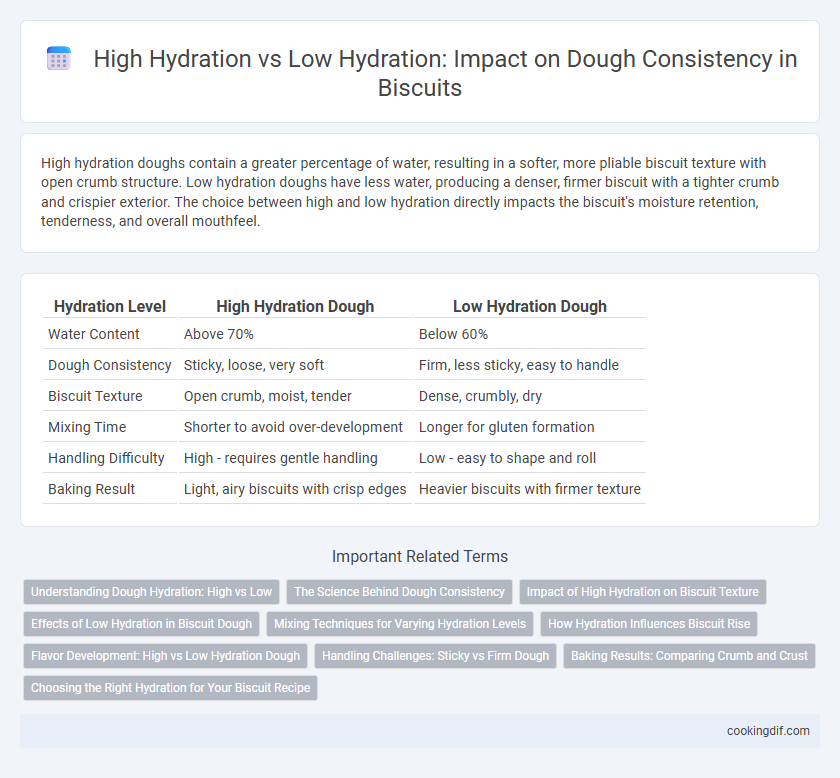High hydration doughs contain a greater percentage of water, resulting in a softer, more pliable biscuit texture with open crumb structure. Low hydration doughs have less water, producing a denser, firmer biscuit with a tighter crumb and crispier exterior. The choice between high and low hydration directly impacts the biscuit's moisture retention, tenderness, and overall mouthfeel.
Table of Comparison
| Hydration Level | High Hydration Dough | Low Hydration Dough |
|---|---|---|
| Water Content | Above 70% | Below 60% |
| Dough Consistency | Sticky, loose, very soft | Firm, less sticky, easy to handle |
| Biscuit Texture | Open crumb, moist, tender | Dense, crumbly, dry |
| Mixing Time | Shorter to avoid over-development | Longer for gluten formation |
| Handling Difficulty | High - requires gentle handling | Low - easy to shape and roll |
| Baking Result | Light, airy biscuits with crisp edges | Heavier biscuits with firmer texture |
Understanding Dough Hydration: High vs Low
High hydration dough, typically containing 70% or more water relative to flour weight, produces a softer, airier biscuit texture with an open crumb structure and higher moisture retention. Low hydration dough, usually around 50-60% water, results in a firmer, denser biscuit with a tighter crumb and more pronounced flakiness due to reduced gluten development. Adjusting hydration levels directly impacts dough extensibility, gluten formation, and final biscuit mouthfeel, making hydration a crucial factor in recipe optimization.
The Science Behind Dough Consistency
High hydration doughs contain a higher water-to-flour ratio, resulting in a softer, more extensible biscuit texture due to increased gluten development and starch gelatinization. Low hydration doughs yield a firmer, denser biscuit by limiting water absorption, which restricts gluten network formation and retains shape during baking. Understanding the precise water content is essential to controlling dough rheology, crumb structure, and overall biscuit quality.
Impact of High Hydration on Biscuit Texture
High hydration dough in biscuits results in a softer, more tender crumb with increased moisture and a lighter texture due to greater steam generation during baking. This elevated water content promotes gluten development, enhancing the dough's elasticity and allowing it to rise more effectively. Biscuits made with high hydration dough typically exhibit a flaky, airy structure compared to the denser, crumbly texture of low hydration counterparts.
Effects of Low Hydration in Biscuit Dough
Low hydration in biscuit dough results in a stiffer, denser texture that limits gluten development and produces a crumbly, tender biscuit. Reduced water content restricts starch gelatinization and yeast activity, leading to less rise and a more compact crumb structure. This dough consistency is ideal for biscuits requiring a flaky, firm bite and controlled spread during baking.
Mixing Techniques for Varying Hydration Levels
High hydration doughs for biscuits require gentle folding and minimal mixing to maintain air pockets and achieve a tender crumb, whereas low hydration doughs benefit from more vigorous mixing to develop gluten structure for flakier layers. Mixing techniques such as using a pastry cutter or cold butter incorporation are crucial for low hydration doughs to create distinct layers, while high hydration doughs rely on careful handling to prevent overworking the batter. Adjusting mixing times and methods based on hydration levels ensures optimal dough consistency and biscuit texture.
How Hydration Influences Biscuit Rise
High hydration doughs provide increased moisture content, resulting in a tender crumb and a higher rise due to better steam formation during baking. Low hydration doughs produce a denser texture with limited expansion, as less water restricts gluten development and steam release. The balance of hydration directly influences biscuit flakiness, crumb softness, and overall volume.
Flavor Development: High vs Low Hydration Dough
High hydration dough encourages greater fermentation activity, resulting in enhanced flavor complexity and a more pronounced tang in biscuits due to increased enzyme and yeast interaction. Low hydration dough produces a denser texture with milder, less developed flavors as limited moisture restricts fermentation and enzymatic processes. Optimal flavor development in biscuits is often achieved by balancing hydration to promote sufficient fermentation while maintaining dough workability.
Handling Challenges: Sticky vs Firm Dough
High hydration biscuit dough tends to be sticky, causing challenges in handling, shaping, and transferring due to its increased moisture content. Low hydration dough is firmer and easier to manipulate but may result in denser biscuits with less tenderness. Balancing hydration levels is essential to achieve optimal dough consistency while minimizing stickiness and handling difficulties.
Baking Results: Comparing Crumb and Crust
High hydration dough produces biscuits with a more open, airy crumb and a thinner, crispier crust due to increased moisture content. Low hydration dough yields a denser, tighter crumb structure and a thicker, chewier crust, resulting from reduced water in the mixture. Baking with high hydration improves softness and rise, while low hydration enhances flakiness and structural integrity in the final biscuit.
Choosing the Right Hydration for Your Biscuit Recipe
High hydration doughs yield a softer, more tender biscuit with increased crumb moisture, ideal for achieving a delicate texture. Low hydration doughs produce a firmer, denser biscuit with a crisper crust, perfect for traditional flaky biscuits. Selecting the appropriate hydration level depends on desired biscuit characteristics, balancing moisture content with flour type to optimize dough consistency.
High hydration vs Low hydration for dough consistency Infographic

 cookingdif.com
cookingdif.com